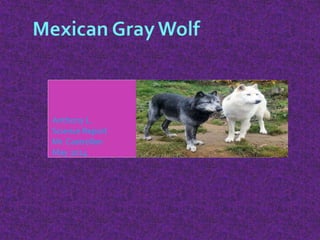
Anthony 2014
- 1. Anthony L. Science Report Mr. Castrellon May 2014
- 2. This presentation will be about the Mexican GrayWolf.You will learn about their diet, habitat, map range, interesting facts, family life, anatomy, and lastly its scientific name is Canis lupus bailey
- 3. Wolves live in a family group called packs. A pack includes a male and a female wolf, their young, and a few wolves that have joined from other packs. Wolves need each other. Together they find food, protect one another and care for their young. A wolf alone can’t survive for long. Pack members take care of each other. They help one another hunt, travel and feed. Together they fight off enemies. Wolves are good parents. In the spring, the mother goes into an underground den to give birth to her cubs.
- 4. They live in hot places like deserts. Mexican gray wolves prefer mountains, forests, grass lands and scrub lands.
- 5. The Mexican gray wolf ranged the Sonora and Chihuahuan deserts in central Mexico to westernTexas, southern New Mexico and central Arizona.
- 8. Wolves eat small animals such as rabbits. They also eat big animals such as deer and elk. They also eat about 20 pounds of meat that’s about 200 hotdogs. In fact, wolves only catch about one out of every deer.
- 9. The scientific name is Canis lupus bailey
- 10. pup juvenile
- 11. The Mexican wolf maximum height is about 80 centimeters it is around the size of a German Sheppard. The wolf’s height is 26-32 inches at the shoulder. Length 4-5 through nose to tip of tail. Shoulder height 26 inches to 38 Inches.